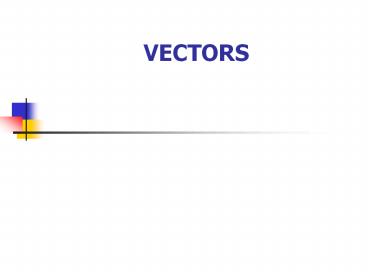VECTORS - PowerPoint PPT Presentation
1 / 34
Title: VECTORS
1
VECTORS
2
Vectors
- A person walks 5 meters South, then 6 meters
West. - How far did he walk?
3
Vectors
- A person walks 5 meters North, then 6 meters
East. - How far did he walk?
- What is his displacement?
4
Scalars Vectors
- A scalar is a quantity that has magnitude (size)
only. - Vectors are quantities that have size and
direction.
5
Examples
- Scalars 5 m. 7 m/s.
- Vectors 5 m South. 7 m/s up.
6
Vectors
- Vectors have magnitude5 m 7 m/s
- AND
- Vectors have directionSouth Up
7
Drawing vectors.
- Vectors are drawn as arrows.
- Length of the arrow is proportional to the
magnitude of the vector. - (The bigger the number,
- the longer the arrow!)
8
Vector Arithmetic
- Vectors can be multiplied by numbers.
- If A 5 m North, 2A 10 m North
9
Vector Arithmetic
- Negative signs flip the direction.
10
Vectors
- Vectors can be added together.
- To show vector addition graphically, you need to
draw the vectors - To scale
- Tip to Tail.
- The red line is the sum of the other
two vectors and is called the resultant. - Adding vectors gives a displacement, not a
distance.
11
Graphic Addition Examples
12
- Switch to Notebook to draw vector answers or
write on White Board on top of projection.
13
Vector Arithmetic
14
Common notation
- A vector will usually be given as a length at
some angle. - I.e. 4 m _at_ 60? or 7 m _at_ 235?
15
Common Notation
- The angle listed will be measured counter
clockwise from the x axis.(unless otherwise
specified)
16
Common Notation
- The angle listed will be measured counter
clockwise from the x axis.(unless otherwise
specified)
17
ADDING VECTORS ALGEBRAICALLY
- Adding vectors using algebra gives us a much more
exact number than doing it graphically. - To add vectors algebraically, you need to
remember a little geometry and trigonometry.
18
PERPENDICULAR VECTORS
- When vectors are at right angles to each other,
we can find both the size and direction. - We find the magnitude of the resultant by using
the Pythagorean Theorem (a2 b2 c2 ). - We find the direction (angle) of the resultant by
using inverse cosine or inverse tangent functions.
19
Find the resultant.
- A 6 m _at_ 0 deg.
- B 9 m _at_ 90 deg.
- What is A B?
20
Adding parts.
- Add parts together to get same answer as adding
wholes together, just like adding vectors. For
example - Adding Wholes 2 7 9
- Adding Parts 2 1 1 and 7 3 4 so
- (1 1) (3 4) 9 and is the same as
adding wholes above.
21
Components
- Any vector can be treated like the sum of 2
vectors or broken into 2 parts. - A vector can be treated like a horizontal (x)
vector and a - vertical (y) vector added together.
- X means a unit vector in the X direction.
- y means a unit vector in the y direction.
22
Components
- Vector A
- Ax is the horizontal component of A
- Ay is the vertical component of A
23
Trig Review
- Vector A of length A is the hypotenuse.
- X is the length or magnitude of the
- X component (vector Ax).
- Y is the length or magnitude of the
- Y component (vector Ay).
- Cos Q (X/A) Sin Q (Y/A) or
- X A Cos Q Y A Sin Q
- Inverse Cos is written as Cos -1 .
- Inverse Cos asks what angle produces that Cos.
- Cos -1 (X/A) gives Q or Tan -1 (Y/X) gives Q
y
Q
X
24
ADDING NON-PERPENDICULAR VECTORS
- When vectors are applied at different angles, we
need to break them into their vertical (y) and
horizontal (x) pieces. - Then we can find (S is sigma sum)
- S x and S y
- Use Pythagorean Theorem to find resultant
magnitude (M). - (S x)2 (S y)2 M2
- Use Inv Cos S x to find resultant
- M direction angle.
25
EXAMPLE
- A 50 km at 110 deg
- B 30 km at 60 deg
A 50 km
B 30 km
? 110o
? 60o
26
Example
- We want A B
27
EXAMPLE
- The resultant is the vector made from the
combined components of the two original vectors.
A 50 km
B 30 km
? 110o
? 60o
28
- X Ax BX The Horizontal of A The
horizontal of B - X 50cos(110) 30 cos(60)
- X -17.1 15 -2.1
29
- Y AY BY The Vertical of A The Vertical of
B - Y 50sin(110) 30 sin(60)
- Y 47.0 26.0 73.0
30
- C -2.1 Horizontal
- 73 Vertical
31
How long is C?
- C2 (-2.1)2 (73)2
- C 73.03
32
What is the angle of C?
- cos Q -2.1 / 73.03
- Q cos -1(-2.1 / 73.03)
- Q 91.6 degrees
33
(No Transcript)
34
Find the resultant
- C 5 km at 30 deg.
- D 9 km at 45 deg.
- Find C D































